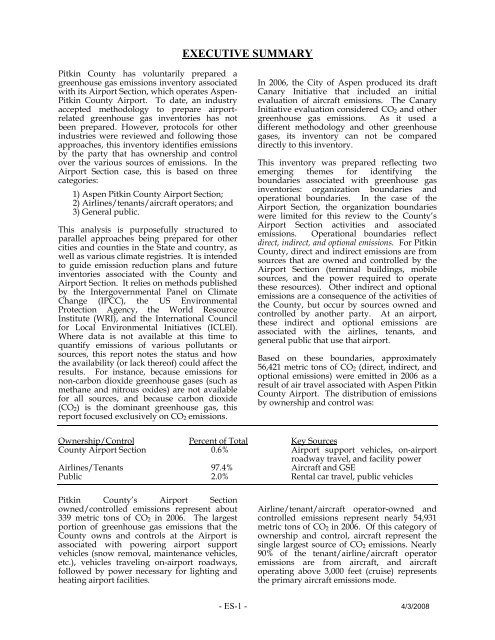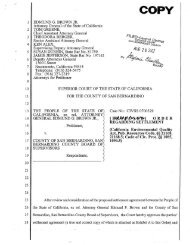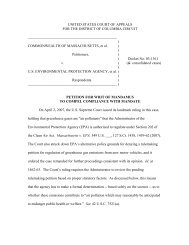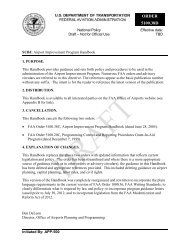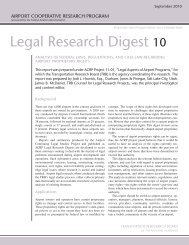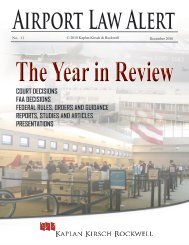Aspen-Pitkin County Airport Greenhouse Gas Emissions Inventory ...
Aspen-Pitkin County Airport Greenhouse Gas Emissions Inventory ...
Aspen-Pitkin County Airport Greenhouse Gas Emissions Inventory ...
Create successful ePaper yourself
Turn your PDF publications into a flip-book with our unique Google optimized e-Paper software.
EXECUTIVE SUMMARY<strong>Pitkin</strong> <strong>County</strong> has voluntarily prepared agreenhouse gas emissions inventory associatedwith its <strong>Airport</strong> Section, which operates <strong>Aspen</strong>-<strong>Pitkin</strong> <strong>County</strong> <strong>Airport</strong>. To date, an industryaccepted methodology to prepare airportrelatedgreenhouse gas inventories has notbeen prepared. However, protocols for otherindustries were reviewed and following thoseapproaches, this inventory identifies emissionsby the party that has ownership and controlover the various sources of emissions. In the<strong>Airport</strong> Section case, this is based on threecategories:1) <strong>Aspen</strong> <strong>Pitkin</strong> <strong>County</strong> <strong>Airport</strong> Section;2) Airlines/tenants/aircraft operators; and3) General public.This analysis is purposefully structured toparallel approaches being prepared for othercities and counties in the State and country, aswell as various climate registries. It is intendedto guide emission reduction plans and futureinventories associated with the <strong>County</strong> and<strong>Airport</strong> Section. It relies on methods publishedby the Intergovernmental Panel on ClimateChange (IPCC), the US EnvironmentalProtection Agency, the World ResourceInstitute (WRI), and the International Councilfor Local Environmental Initiatives (ICLEI).Where data is not available at this time toquantify emissions of various pollutants orsources, this report notes the status and howthe availability (or lack thereof) could affect theresults. For instance, because emissions fornon-carbon dioxide greenhouse gases (such asmethane and nitrous oxides) are not availablefor all sources, and because carbon dioxide(CO 2 ) is the dominant greenhouse gas, thisreport focused exclusively on CO 2 emissions.In 2006, the City of <strong>Aspen</strong> produced its draftCanary Initiative that included an initialevaluation of aircraft emissions. The CanaryInitiative evaluation considered CO 2 and othergreenhouse gas emissions. As it used adifferent methodology and other greenhousegases, its inventory can not be compareddirectly to this inventory.This inventory was prepared reflecting twoemerging themes for identifying theboundaries associated with greenhouse gasinventories: organization boundaries andoperational boundaries. In the case of the<strong>Airport</strong> Section, the organization boundarieswere limited for this review to the <strong>County</strong>’s<strong>Airport</strong> Section activities and associatedemissions. Operational boundaries reflectdirect, indirect, and optional emissions. For <strong>Pitkin</strong><strong>County</strong>, direct and indirect emissions are fromsources that are owned and controlled by the<strong>Airport</strong> Section (terminal buildings, mobilesources, and the power required to operatethese resources). Other indirect and optionalemissions are a consequence of the activities ofthe <strong>County</strong>, but occur by sources owned andcontrolled by another party. At an airport,these indirect and optional emissions areassociated with the airlines, tenants, andgeneral public that use that airport.Based on these boundaries, approximately56,421 metric tons of CO 2 (direct, indirect, andoptional emissions) were emitted in 2006 as aresult of air travel associated with <strong>Aspen</strong> <strong>Pitkin</strong><strong>County</strong> <strong>Airport</strong>. The distribution of emissionsby ownership and control was:Ownership/Control Percent of Total Key Sources<strong>County</strong> <strong>Airport</strong> Section 0.6% <strong>Airport</strong> support vehicles, on-airportroadway travel, and facility powerAirlines/Tenants 97.4% Aircraft and GSEPublic 2.0% Rental car travel, public vehicles<strong>Pitkin</strong> <strong>County</strong>’s <strong>Airport</strong> Sectionowned/controlled emissions represent about339 metric tons of CO 2 in 2006. The largestportion of greenhouse gas emissions that the<strong>County</strong> owns and controls at the <strong>Airport</strong> isassociated with powering airport supportvehicles (snow removal, maintenance vehicles,etc.), vehicles traveling on-airport roadways,followed by power necessary for lighting andheating airport facilities.Airline/tenant/aircraft operator-owned andcontrolled emissions represent nearly 54,931metric tons of CO 2 in 2006. Of this category ofownership and control, aircraft represent thesingle largest source of CO 2 emissions. Nearly90% of the tenant/airline/aircraft operatoremissions are from aircraft, and aircraftoperating above 3,000 feet (cruise) representsthe primary aircraft emissions mode.- ES-1 - 4/3/2008


